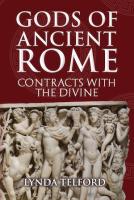
Amberley (2024) h/b 268pp £22.99 (ISBN 9781398111646)
This is an extremely detailed and comprehensive volume which endeavours to cover every aspect of religious beliefs, gods, spirits, festivals, magic and similar such things throughout the Roman world, from the earliest times of the Etruscans and the founding of the city of Rome through to the Empire and its last days. It includes a number of illustrations, a bibliography, footnotes and index. T. certainly succeeds in her intention to provide a book which is completely accessible to readers with no knowledge of the classical languages. She is not a classicist herself, but a keen amateur archaeologist and historian.
The first chapter, entitled ‘Faceless Gods’, explains how the Romans believed that, even when they were undertaking the smallest task, their gods must always be appeased. When people or even animals, such as the guard dogs who failed to prevent the sack of Rome by the Gauls, were found wanting they would be severely punished to appease the gods. Frequently, it was the Vestal Virgins who bore the brunt of such justice. T. also describes the early non-anthropomorphic gods, such as Ops (Plenty), Fides (Faith) and those connected with the harvest and everyday life, and their worship, as well as personified ones such as Castor and Pollux. However, one might observe that the latter group were not necessarily ‘faceless’.
Chapter 2 describes individually the female gods, both the older ones, such as Anna Perenna, as well as the Olympians. T. follows a strict alphabetical order in this and the following two chapters, so Angerona and Bellona precede Ceres, and Venus follows the Sybils and Tellus, with few clues as to relative importance. This method becomes even more confusing to the reader in Chapter 3 where not only are a huge number of male gods described, but also, as some separate entries, Festivals and Divine Locations. So we find Jupiter, followed by Lares and Lectisternium (spreading a couch or a feast). In the fourth chapter, T. expounds on the foreign gods worshipped by the Romans, but begins with Isis, as the most important, before reverting to her alphabetical sequence.
Emperor worship is tackled in Chapter 5, which starts with a very clear explanation of how Roman democracy evolved into rule by a single leader, beginning from Marius and Sulla. T. includes much Roman history here as well as explaining the lifetime cults of Augustus, before his deification, which became a precedent for future emperors. Chapter 6 tackles divination, auguries and omens, stressing their appeal to the poorer classes. T. again includes much Roman history, particularly referring to Julius Caesar, as well as describing some of the most common signs and omens. Magic is the topic of Chapter 7, which encompasses practices from all parts of the Roman World and from all periods. T. relates in detail the use of spells, curses, alchemy and astrolabes and describes magic as ‘...potentially the great equaliser, giving hope to those people to whom fate has been less than kind, and (it) seemed … to be the way to achieve for oneself the blessings and successes that fate withheld.’ The final chapter briefly summarises the festivals which occurred in each calendar month. However, T. chooses, anachronistically, to use the 12-month Gregorian calendar, which was not introduced until the 16th century. In her conclusion, T. stresses the inclusivity of Roman religion and also explains why she has chosen not to include a section on Christianity.
This book is an encyclopaedic account of almost all aspects of Roman Religion from earliest times until the fall of the Empire. It would be a useful reference book for those wishing to learn more about any particular deity, festival or ritual and to understand something of what religion and the gods meant to those from all classes during the Roman Republic and Empire.
Marion Gibbs
